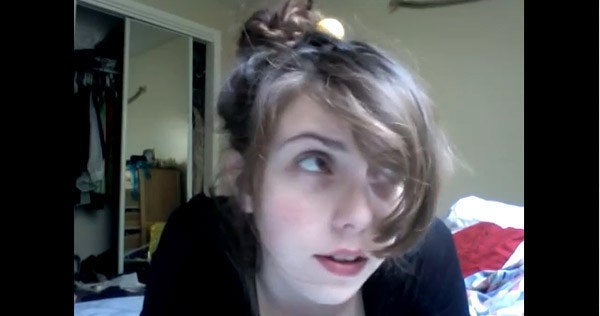
Last summer I came across several YouTube videos of pre-teen and early teenage girls. They made web cam videos of themselves asking if they were "pretty or ugly," and asked the viewers to leave comments telling them the truth about their looks. These girls stutter and pause, looking into the camera with wide eyes, and then quickly glance away, their voices sincere and loaded with the heavy question. The videos made me cringe as I thought, "How awful." I just wanted to hug them like I was their older sister.
Five months ago I decided to make my own "Am I Pretty?" video. Something kept drawing me back to these girls. I understood where they were coming from on a personal level; watching these videos triggered my memories from middle school, of wondering the same thing. Creating an "Am I Pretty?" video would allow me to step back into that fragile emotional state, as well as force a reaction from older viewers.
Most of my work is about some of the conditions of being a woman; the battles a girl must go through to deal with society's contradictory ideals of feminism and sexuality. My art reflects the insecurities, obsessions and interests that teenage girls and young women experience during this difficult and confusing time.
I researched ways to help the video get more views. Gathering comments was an integral part of the piece, an inside look into the culture of "trolling" and cyber bullying. I took advantage of my looking young for my age, and I made sure to put my hair in front of my face to appear insecure. "Am I Pretty/ Am I Ugly?" sat on Youtube for a few months, and I forgot about it.
Last month my roommate posted a link on my Facebook page to an article on Jezebel.com. The article, "Tragic Trend: Teens Ask YouTube commenters If They're Ugly" by Katie J.M. Baker, used my video as one of the three examples. It was just a funny coincidence. A "that's weird" moment.
But within two days the story blew up. It seemed as if every news station was doing a story about "tragic teens." I was contacted for interviews by Good Morning America, Inside Edition, and CBS's The Talk. The whole country thought I was a 12-year-old girl. I was surprised, and excited that my piece was getting so much attention. But it was also very strange.
At first I was tempted to run with it, pretend the video was real and go on national TV and announce to the country how insecure I was. It would be the ultimate performance piece, a Warholian act. "Pulling one over on America." But I realized (with the help of my Dad) that the only people who would know I was lying were the people close to me, and the rest of the country would merely feel sorry for "me."
Although I knew the press would lose interest, I followed my father's advice and told the journalists from the shows that the video was an art piece, a social commentary, made for the similar reasons that they were covering it. They all said "Oh," in the same disappointed sigh.
The video wasn't real. I wasn't 12, so it didn't matter. I sent an email to the writer of the Jezebel article, but I didn't hear back.
I decided to put a disclaimer under the piece explaining the motivation behind it. I had a feeling the statement would not be read, because people don't go to YouTube to read. I was right. Yahoo News used the video, and the morning after that it was on NBC's Today Show. The video gained 20,000 views within hours after the episode was aired.
People started coming up to me at school to give me advice. Some were teasing, but some, even though they knew me, thought the video was real. I would just laugh it off, and was thankful that the video wasn't sincere.
I told my painting teacher, James Brinsfield, about the publicity, and he relayed the information to his wife, Alice Thorson, the art critic for the Kansas City Star. She interviewed me, as did a couple of local news stations.
Then I heard back from Katie Baker, the author of the original "Tween Trend" article that started the whole thing. She published a follow-up article on Jezebel, "Meet the 21-Year-Old Art Student Who Tricked Folks (Including GMA) Into Thinking She Was a Tween."
Again, this article caught on quickly. It was on Daily Mail UK as well as MSNBC, with titles like "'Insecure tween' who asked YouTube watchers 'am I ugly?' outs herself as 21-year-old arts student." After these articles, I am still getting responses to the video as if it was real.
Even though this experience has provided both a social commentary on the power of the internet and the anonymous Youtube community, and an eye-opening look into the speed and processes behind everyday news, "Am I Pretty/ Am I Ugly" remains what I intended it to be. I am glad that it brought attention to these issues.
I am pleased that my work has gained attention for what it is. But I can't help but wonder how the girls of the original videos feel now, after their videos have been seen nationally. How are people treating them in light of their recent "fame?"